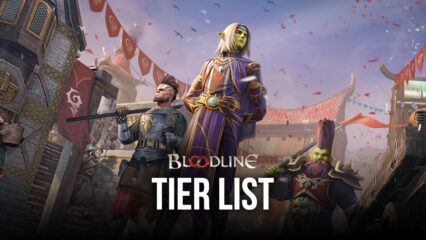Bloodline: Heroes of Lithas Beginner’s Guide - Everything You Need to Know Before Starting your Adventure

A brand new game has graced the mobile market, this time in the form of Bloodline: Heroes of Lithas, a gacha RPG that promises to revolutionize the genre with a brand new heir and companion system. Sadly, the folks at Goat Games didn’t seem to notice that this system already exists in other titles, most notably in Game of Sultans, which was infamous for its courtesan system. And while the companion mechanic in Bloodline isn’t as egregious, it’s still quite on the nose at best, and nothing new at worst.

This doesn’t mean that Bloodline is bad at all; it’s just that the novelty of its “new” systems will wear off very quickly if you’re already familiar with other games that have it. Regardless, this game also has interesting city building mechanics, coupled with an engaging progression system revolving around completing different stages of increasing difficulty. And while the combat mechanics aren’t anything new either, they are wonderfully complemented by the game’s amazing graphics and presentation, which is by far the strongest aspect of Bloodline: Heroes of Lithas.
With that being said, while Bloodline: Heroes of Lithas brings nothing new to the table, the way it combines its elements makes it a truly interesting experience for the users, not to mention that it can be quite overwhelming if you’re a newcomer to the game, or to the genre in general. Luckily, in this beginner’s guide, you’ll find everything you need to know about this game, in order to get the best start.
Play on BlueStacks to Get the Best Experience
Having a blast with any of your mobile games always starts with playing it on the appropriate platform. And while these games are designed and developed to be played on your phone, you can have the best experience with Bloodline: Heroes of Lithas by playing it on PC with BlueStacks.
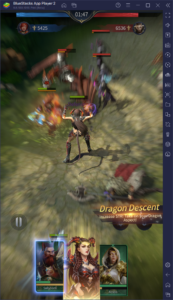
Our Android App player is much faster than even the most expensive flagship phones on the market, allowing you to play even the most demanding games like this one, with the best graphics and performance, and without having to spend tons of money on a decent device. As long as your PC fulfills the recommended requirements to run BlueStacks, which are very accessible by today’s standards, you can play with the highest graphical settings, without having to sacrifice performance.
Check out our PC setup guide for Bloodline: Heroes of Lithas to learn how to get started with playing this game on your computer.
Combat Basics
Most of the gameplay in Bloodline: Heroes of Lithas revolves around progressing through several chapters in the campaign, each with a variety of levels of increasing difficulty. In each of these stages, you’ll fight against enemy formations in real-time, with your units moving, engaging, and attacking automatically. Your role in these battles is to use your units’ special abilities when their special gauges are full. The proper use of these skills can mean the difference between an easy victory or a crushing defeat.
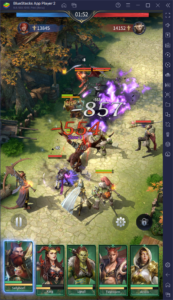
Every time one of your heroes lands an attack, their special gauge will fill up a little bit. Once it’s full, their portrait will light up and you can click on them to unleash their skills. These abilities vary wildly in use, with some of them dealing damage to either single or multiple targets, others healing or shielding allies, and some even buffing teammates or crippling the enemy. This means that, aside from using your abilities correctly, you also need to consider your team composition, and choose characters with good synergy.

There’s not much to the combat in this game, since it’s mostly automatic. As a general rule of thumb, however, you’ll want to use the auto-battle when farming or grinding the easier battles. On the flipside, for the tougher levels, you will definitely want to assume manual control so that you can use your unit abilities at the right moments, since the CPU can’t do very well on its own.
The Districts System
Aside from marching to the field and fighting enemies, you’ll also have to work on developing your empire, since this is where a lot of your gold will come from. The Districts feature is unlocked fairly early into the game, starting with the Market District.
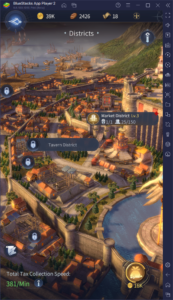
Each District produces a set amount of gold in the form of taxes, though they can be upgraded to increase their production. Fortunately, all districts are developed in the same manner: You must first fulfill certain prerequisites before you can unlock a district. These can be as simple as completing certain stages in the campaign. Once unlocked, you’ll need to pay with Construction Plans to rebuild the district in question, after which they will start generating resources automatically over time.
Once rebuilt, you can boost the production of a district in several ways, such as by hiring workers, which requires you to pay them with food. Additionally, you can assign specific heroes to the different districts, which will speed up the rate at which they produce resources. Lastly, you can also directly upgrade the district in question by paying with additional Construction Plans.
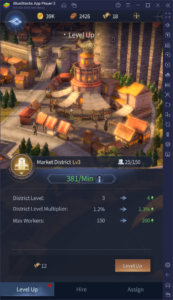
Upgrading districts, hiring workers, and assigning the right heroes for the task will be instrumental in optimizing your resource production in Bloodline: Heroes of Lithas.
Understanding the Heir System
Last but not least, the final system we wanted to talk about in this Bloodline: Heroes of Lithas beginner’s guide is the heir system, which is where you’ll produce some of the best champions in the game. However, as a disclaimer, we realize how weird and possibly off-putting this system can sound, as we’re essentially using our companions as objects just to produce babies. But hey, it’s a game and we’re going to be treating it as such.

The heir system is quite simple: Once you unlock companions in the first chapter of the campaign, you can “interact” with them every few hours to have them produce a baby. This baby, in turn, will go through a few development stages before they can turn into an adult, and join your army.
There are a few factors that come into play when determining the potential and quality of an heir. First and foremost, the level of intimacy with the companion will determine the rarity of the baby, with a higher rarity indicating a better potential once they become adults. You can increase a companion’s intimacy level by giving them gifts, which will slowly fill up their intimacy bar. Once full, they will progress to the next intimacy level, and will be able to bear heirs of higher rarity.
Additionally, once they’re born, you’ll need to interact with your heirs a set number of times before they can grow into an infant, and then into an adult. During these interactions, you can choose to either play with them, train them in combat, or have them study, which in turn will affect their development. The specifics of these interactions are not clear, though we know that the higher the rarity of the heir, the more and better traits they will pick up once they turn into champions.

And that’s it for our Bloodline: Heroes of Lithas beginner’s guide. Feel free to share your own thoughts and comments in the section below!




